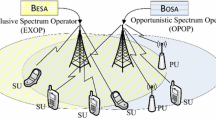Abstract
Amid the dynamic spectrum access in cognitive radio networks, when complex spectrum conditions should be taken into account, how to price the spectrum in order to benefit primary systems in maximization is still under-investigated. In this paper, we devise a spectrum pricing method to address this issue in cognitive networks. In our proposed mechanism, leasing spectrum is collected for uniform selling and classified into three kinds of channels—high-quality channel, mid-quality channel and low-quality channel, respectively. They will be priced variously according to different interference characteristics caused by versatile path fading and user positions. In respond to heterogeneous channel qualities, secondary users also have own selection preferences. They can purchase one kind of channel for usage in based of channel quality and available budget. Then, we obtain the final pricing solution which is an iterative algorithm converging to a fixed point. Also, the existence of a pure Nash equilibrium is discussed to ensure the rationality of the method. In numerical results, we evaluate the effects of this proposal in spectrum pricing and primary systems’ profits.










Similar content being viewed by others
References
Zhao, N., Yu, F. R., Sun, H., & Li, M. (2016). Adaptive power allocation schemes for spectrum sharing in interference-alignment-based cognitive radio networks. IEEE Transactions on Vehicular Technology, 65(5), 3700–3714.
Li, X., Zhao, N., Sun, Y., & Yu, F. R. (2016). Interference alignment based on antenna selection with imperfect channel state information in cognitive radio networks. IEEE Transactions on Vehicular Technology, 65(7), 5497–5511.
Yang, C., Li, J., & Anpalagan, A. (2015). Hierarchical decision-making with information asymmetry for spectrum sharing systems. IEEE Transactions on Vehicular Technology, 64(9), 4359–4364.
Liu, X., Li, F., & Na, Z. (2017). Optimal resource allocation in simultaneous cooperative spectrum sensing and energy harvesting for multichannel cognitive radio. IEEE Access, 5, 3801–3812.
Joshi, H., Kumar, R., Yadav, A., & Darak, S. J. (2018). Distributed algorithm for dynamic spectrum access in infrastructure-less cognitive radio network. In IEEE WCNC (pp. 1–6).
Zhu, X., Liu, X., Xu, Y., et al. (2017). Dynamic spectrum access for D2D networks: A hypergraph game approach. In IEEE ICCT (pp. 861–866).
Li, F., Lam, K. Y., Li, X., et al. (2018). Dynamic spectrum access networks with heterogeneous users: How to price the spectrum? IEEE Transactions on Vehicular Technology, 67(6), 5203–5216.
Sun, H., Wang, X., Wang, C., et al. (2017). Performance analysis of network attack based on continuous time Markov Chain in dynamic spectrum access networks. In ICMIC (pp. 302–307).
Yawada, P. S., & Wei, A. J. (2016). Comparative study of spectrum sensing techniques base on techniques non-cooperative in cognitive radio networks. In International conference on computer science and network (pp. 517–520).
Suganthi, N., & Meenakshi, S. (2017). Effective spectrum resource sharing with dynamic handoff process in cognitive radio networks. In International conference on information communication and embedded systems (pp. 1–5).
Muralidharan, A., Venkateswaran, P., Ajay, S. G., et al. (2015). An adaptive threshold method for energy based spectrum sensing in Cognitive Radio Networks. In International conference on control, instrumentation, communication and computational technologies (pp. 8–11).
Tsiftsis, T. A., Foukalas, F., Karagiannidis, G. K., et al. (2016). On the higher order statistics of the channel capacity in dispersed spectrum cognitive radio systems over generalized fading channels. IEEE Transactions on Vehicular Technology, 65(5), 3818–3823.
Zeeshan, M., Sattar, K., Shah, Z., et al. (2013). Routing and spectrum decision in single transceiver cognitive radio networks. In IEEE VTC (pp. 1–5).
Pan, M., Long, Y., Yue, H., et al. (2012). Multicast throughput optimization and fair spectrum sharing in cognitive radio networks. In IEEE Globecom (pp. 1085–1089().
Hotelling, H. (1929). Stability in competition. The Economic Journal, 39, 41–57.
Khaledi, M., & Abouzeid, A. A. (2015). Dynamic spectrum sharing auction with time-evolving channel qualities. IEEE Transactions on Wireless Communications, 14(11), 5900–5912.
Zhang, S., Hafid, A. S., Zhao, H., & Wang, S. (2018). Impact of heterogeneous fading channels in power limited cognitive radio networks. IEEE Transactions on Cognitive Communications and Networking, 4(1), 1–14.
Wang, S., et al. (2013). Resource allocation for heterogeneous cognitive radio networks with imperfect spectrum sensing. IEEE Journal on Selected Areas in Communications, 31(3), 464–475.
Cao, X., et al. (2015). Cognitive radio networks with heterogeneous users: How to procure and price the spectrum? IEEE Transactions on Wireless Communications, 14(3), 1676–1688.
Yi, C., & Cai, J. (2015). Multi-item spectrum auction for recall-based cognitive radio networks with multiple heterogeneous secondary users. IEEE Transactions on Vehicular Technology, 64(2), 781–792.
Li, M. (2012). Research of cognitive radio spectrum allocation algorithm based on graph theory (pp. 45–47). Leshan: Southwest Jiaotong University.
Debreu, G. (1952). A social equilibrium existence theorem. In Proceedings of the National Academy of Sciences of USA (pp. 886–893).
Colell, A. M., Whinston, M. D., & Green, J. R. (1995). Microeconomic theory. Oxford: Oxford University Press.
Tan, X., Liu, Y., & Wei, S. (2010). Game-based spectrum allocation in cognitive radio networks. Journal of South China University of Technology, 38(5), 22–26.
Saad, Y. (2003). Iterative methods for sparse linear system (2nd ed., pp. 41–46). Philadelphia: Society for Industrial and Applied Mathematics.
Acknowledgements
The authors would like to thank the editor and the reviewers whose constructive comments will help improve the presentation of this paper. This work was supported by the National Natural Science Foundation of China under Grant 51404211.
Author information
Authors and Affiliations
Corresponding author
Rights and permissions
About this article
Cite this article
Wang, L., Lam, KY., Xiong, M. et al. Spectrum pricing for cognitive radio networks with user’s stochastic distribution. Wireless Netw 25, 2091–2099 (2019). https://doi.org/10.1007/s11276-018-1799-8
Published:
Issue Date:
DOI: https://doi.org/10.1007/s11276-018-1799-8




